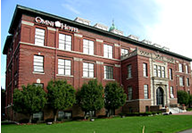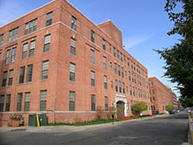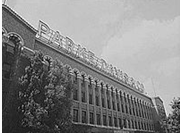
Parke-Davis
USINFO | 2013-08-02 10:19

Parke-Davis is a subsidiary of the pharmaceutical company Pfizer. Although no longer an independent corporation, it was once America's oldest and largest drug maker,[1] and played an important role in medical history.
History


Parke-Davis was founded in Detroit, Michigan by Dr. Samuel P. Duffield, a physician and pharmacist. A partnership of Dr. Duffield and Hervey Coke Parke was formed in 1866, with George S. Davis becoming a third partner in 1867. Duffield withdrew in 1869, and the name Parke, Davis & Company was formally adopted in 1871, being incorporated in 1875. It was once the world's largest pharmaceutical company, and is credited with building the first modern pharmaceutical laboratory and developing the first systematic methods of performing clinical trials of new medications. The Parke-Davis Research Laboratory is aNational Historic Landmark; the surrounding Parke-Davis and Company Pharmaceutical Company Plant is on the National Register of Historic Places.
The production facility on Parkdale Road in what was then Avon Township MI (site now in Rochester MI) was also a landmark in that vicinity, and is now used by JHP Pharmaceuticals.
Parke-Davis was acquired by Warner-Lambert in 1970, which in turn was bought by Pfizer in 2000.
Products
One of Parke-Davis' early products was an amylase isolated from Aspergillus oryzae by Dr. Jokichi Takamine.[2] The enzyme was originally intended for use in distilleries, but was more successfully marketed as "Taka-diastase" for dyspepsia.In addition, Parke-Davis distributed Coley's toxins, the first cancer vaccine, which was developed by William Coley to treat osteosarcoma. In addition, the company entered into a distribution agreement with the Inoculation Department of St Mary's (London) and distributed a number of vaccines for infectious diseases and even acne and cancer.[3]
Another of the company's products developed by Takamine was a pure form of adrenaline. The compound was patented in 1900 and trademarked as "Adrenalin". Because of the similarity of this name to "Adrenaline", the use of the alternative name "epinephrine" for generics was mandated in the United States and is used to this day. Parke-Davis filed a lawsuit against H.K. Mulford alleging infringement of its Adrenalin patents. The ruling in favor of Parke-Davis by judge Learned Hand is considered crucial to modern patent law.
Like Bayer with heroin; before the criminalization of cocaine, the drug was sold by Parke-Davis in various forms, including cigarettes, powder, and even a cocaine mixture that could be injected directly into the user’s veins with the included needle. The company promised that its cocaine products would "supply the place of food, make the coward brave, the silent eloquent and ... render the sufferer insensitive to pain." In October 1915, Aleister Crowley, author of Diary of a Drug Fiend and The Confessions of Aleister Crowley, stopped by Parke-Davis in Detroit, where, according to Crowley, the cooperation was complete. "[They] were kind enough to interest themselves in my researches in Anhalonium lewinii (peyote) and made me some special preparations on the lines indicated by my experience which proved greatly superior to previous preparations."[4] Parke-Davis also was the original manufacturer and patent holder of phencyclidine (PCP) which is currently listed as a Schedule II drug in the United States. They also developed Ketalar (ketamine hydrochloride), a general anesthetic and dissociative drug, in 1962.
Parke-Davis marketed the first widely available epilepsy treatment, Dilantin, which was approved in 1939, although it discovered neither the compound nor the application on its own.[5]
The first bacterial vaccine was developed by Parke-Davis, and the company was thus known as a pioneer in the field of Vaccinology. It was also among the five firms contracted to manufacture the original Salk killed-virus vaccine.[6] A combination of the DPT and polio vaccines, called Quadrigen, was developed in 1954 and approved in 1959. Quadrigen was later removed from the market in 1968 after a series of lawsuits pertaining to adverse effects in vaccinated children. Parke-Davis also produced the broad-spectrum antibiotic chloramphenicol, which was a blockbuster product before discovery of its association with aplastic anemia.
Other products popularized by the company included anti-infectives and brands of combined oral contraceptive pills.
Modern events
In the case of Franklin v. Parke-Davis (2002) the company was accused of illegal marketing practices, including the promotion of off-label uses of its anticonvulsant medication Neurontin.[7] The drug had only been approved for use in patients with epilepsy, but in 2001 over 80% of its $1.8 billion in sales were for indications unapproved by the United States Food and Drug Administration. In 2004, Pfizer "admitted that Parke-Davis aggressively marketed Neurontin by illicit means for unrelated conditions including bipolar disorder, pain, migraine headaches, and drug and alcohol withdrawal", and consented to $430 million dollars in penalties although it claimed the violations originated in 1996, well before Pfizer's acquisition of Warner-Lambert.[8]As announced on January 22, 2007, Pfizer closed its research facilities in Ann Arbor, MI.
Share this page




















